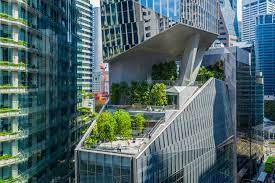“`html
The Rise of Eco-Friendly Architecture
In recent years, eco-friendly architecture has emerged as a significant trend in the construction industry. This innovative approach to building design focuses on minimizing the environmental impact of structures while maximizing energy efficiency and sustainability.
Key Principles of Eco-Friendly Architecture
Eco-friendly architecture incorporates several key principles to create buildings that are environmentally responsible. These principles include:
- Use of sustainable materials such as recycled wood, bamboo, and reclaimed metal
- Integration of renewable energy sources like solar panels and wind turbines
- Implementation of passive design strategies to optimize natural light and ventilation
- Water conservation through rainwater harvesting systems and efficient plumbing fixtures
- Reduced carbon footprint through lower energy consumption and emissions
- Improved indoor air quality for healthier living spaces
- Cost savings on utility bills due to increased energy efficiency
- Enhanced aesthetic appeal with sustainable design elements that blend harmoniously with nature
- Incorporate passive solar design to maximize natural light and heat.
- Use sustainable materials such as bamboo, recycled wood, and reclaimed metal.
- Implement green roofs or living walls to reduce heat island effect and improve air quality.
- Opt for energy-efficient appliances, lighting, and HVAC systems to minimize energy consumption.
- Design with proper insulation and ventilation to enhance thermal comfort and reduce the need for heating/cooling.
- Integrate rainwater harvesting systems and greywater recycling to conserve water resources.
Benefits of Eco-Friendly Architecture
The adoption of eco-friendly architecture offers numerous benefits to both the environment and building occupants. Some of these benefits include:
The Future of Sustainable Building Design
As awareness about climate change and environmental degradation grows, the demand for eco-friendly architecture continues to rise. Architects, designers, and builders are increasingly incorporating sustainable practices into their projects to create a more resilient and environmentally conscious built environment.
Eco-friendly architecture represents a promising path toward a more sustainable future where buildings not only meet the needs of current generations but also preserve resources for future ones.
“`
6 Essential Tips for Creating Eco-Friendly Architecture
Incorporate passive solar design to maximize natural light and heat.
“`html
One effective tip in eco-friendly architecture is to incorporate passive solar design to maximize natural light and heat within buildings. By strategically positioning windows, skylights, and building materials, architects can harness the sun’s energy to illuminate spaces and provide warmth without relying heavily on artificial lighting or heating systems. This approach not only reduces energy consumption but also creates a more comfortable and sustainable indoor environment for occupants. Passive solar design showcases the harmonious integration of nature’s elements into architectural solutions, promoting both environmental responsibility and energy efficiency.
“`
Use sustainable materials such as bamboo, recycled wood, and reclaimed metal.
One key tip in eco-friendly architecture is to prioritize the use of sustainable materials like bamboo, recycled wood, and reclaimed metal. By opting for these environmentally friendly materials, architects and builders can reduce the demand for new resources and minimize waste. Bamboo, known for its rapid growth and renewability, offers a durable and versatile option for construction. Recycled wood not only adds character to a building but also helps divert waste from landfills. Reclaimed metal provides a unique aesthetic while promoting resource conservation. Incorporating these sustainable materials not only enhances the eco-friendliness of a structure but also contributes to a more sustainable building industry overall.
Implement green roofs or living walls to reduce heat island effect and improve air quality.
“`html
One effective tip in eco-friendly architecture is to implement green roofs or living walls, which can significantly reduce the heat island effect and improve air quality. Green roofs, covered with vegetation, help insulate buildings, reducing the need for artificial cooling in hot weather. They also absorb carbon dioxide and release oxygen, contributing to cleaner air and a healthier environment. Similarly, living walls filled with plants act as natural air filters, removing pollutants and enhancing the overall air quality. By incorporating these green features into building design, architects can create sustainable structures that benefit both occupants and the surrounding ecosystem.
“`
Opt for energy-efficient appliances, lighting, and HVAC systems to minimize energy consumption.
“`html
One important tip in eco-friendly architecture is to opt for energy-efficient appliances, lighting, and HVAC systems to minimize energy consumption. By choosing appliances and systems that are designed to operate efficiently, buildings can significantly reduce their environmental impact and lower energy costs. Energy-efficient solutions not only contribute to a greener environment but also promote sustainable living practices that benefit both occupants and the planet.
“`
Design with proper insulation and ventilation to enhance thermal comfort and reduce the need for heating/cooling.
“`html
One essential tip in eco-friendly architecture is to design buildings with proper insulation and ventilation. By incorporating effective insulation materials and well-planned ventilation systems, thermal comfort can be enhanced while reducing the dependency on heating and cooling systems. This not only promotes energy efficiency but also contributes to a sustainable approach by minimizing the carbon footprint of the building. Proper insulation and ventilation play a crucial role in creating a comfortable indoor environment while aligning with eco-friendly principles of sustainable design.
“`
Integrate rainwater harvesting systems and greywater recycling to conserve water resources.
“`html
One effective tip in eco-friendly architecture is to integrate rainwater harvesting systems and greywater recycling to conserve water resources. By capturing rainwater for non-potable uses and recycling greywater from sinks and showers, buildings can significantly reduce their dependence on municipal water supplies. This sustainable approach not only helps in water conservation but also promotes a more efficient use of resources, contributing to a greener and more environmentally friendly built environment.
“`

